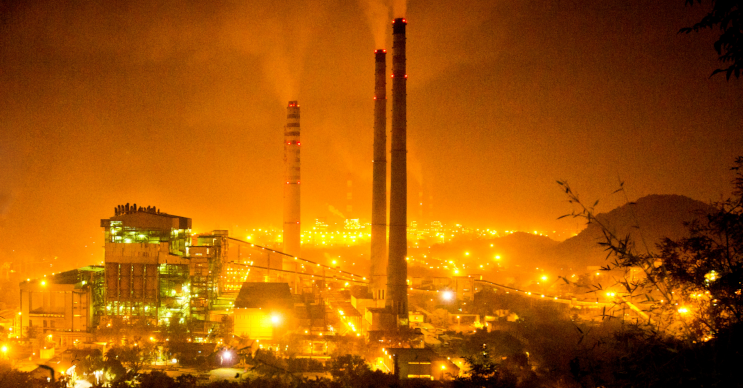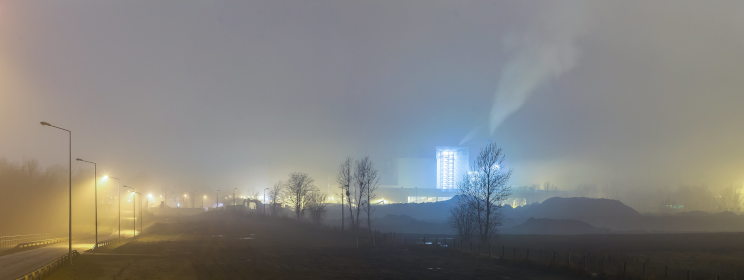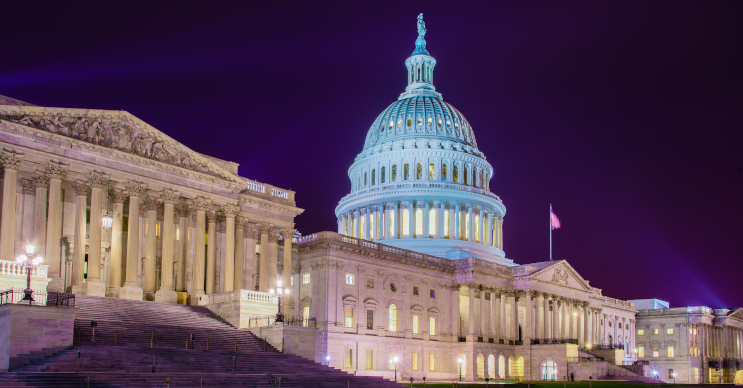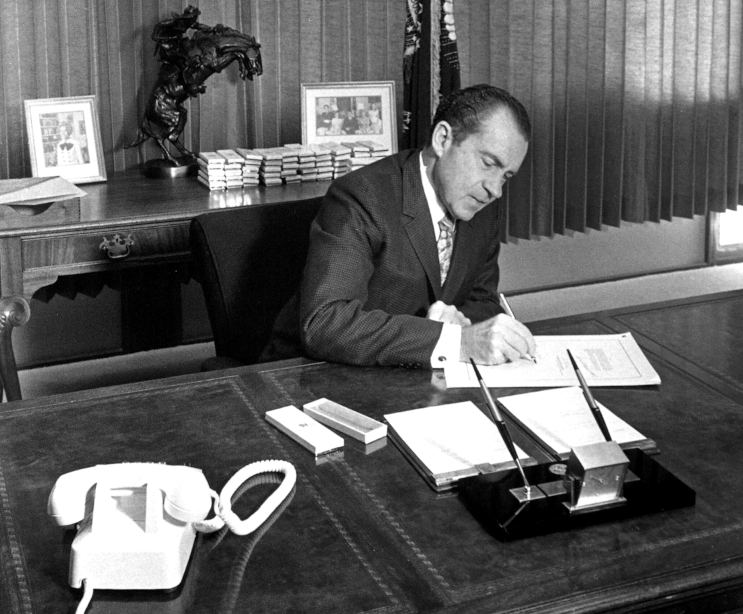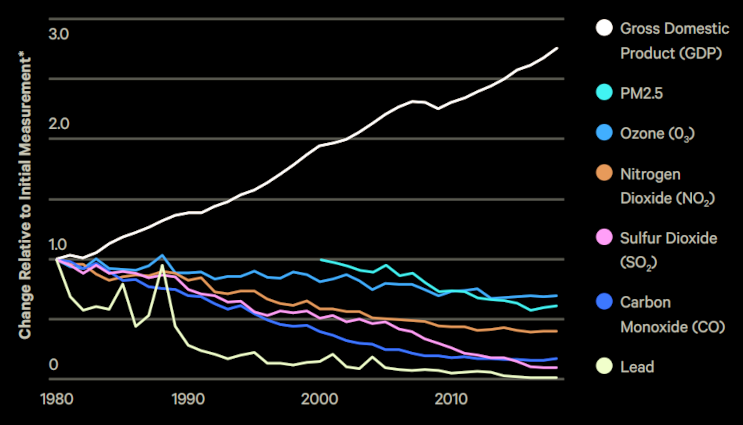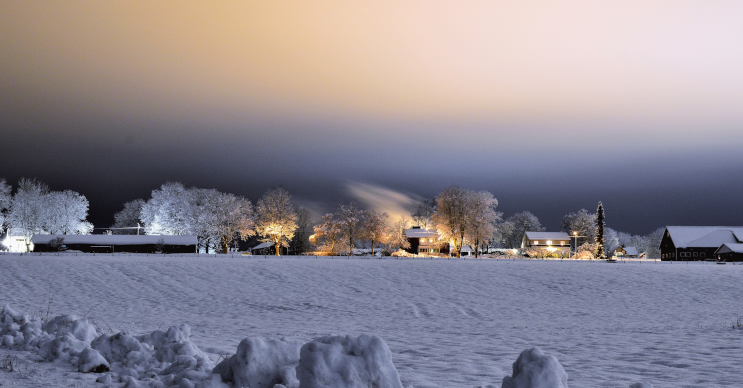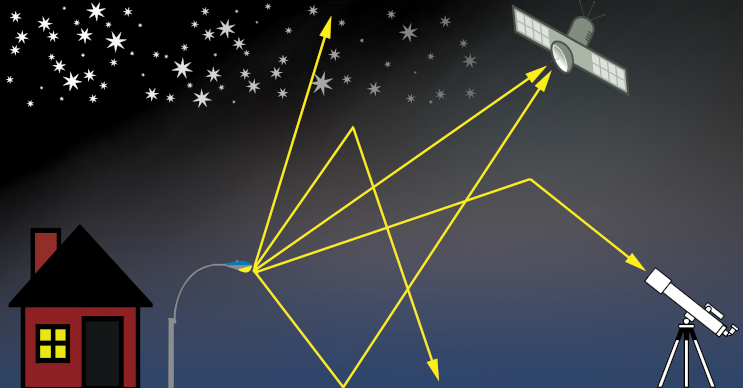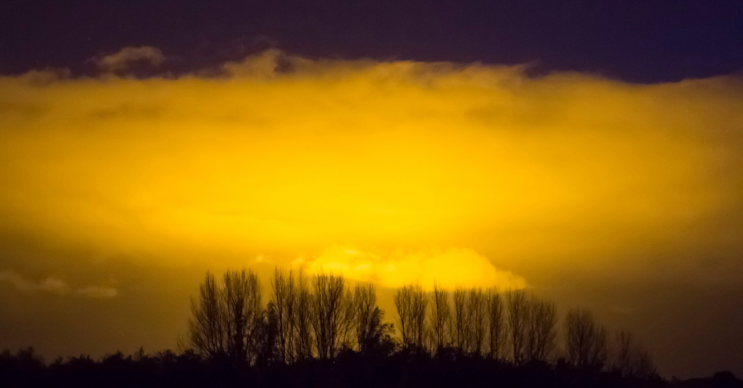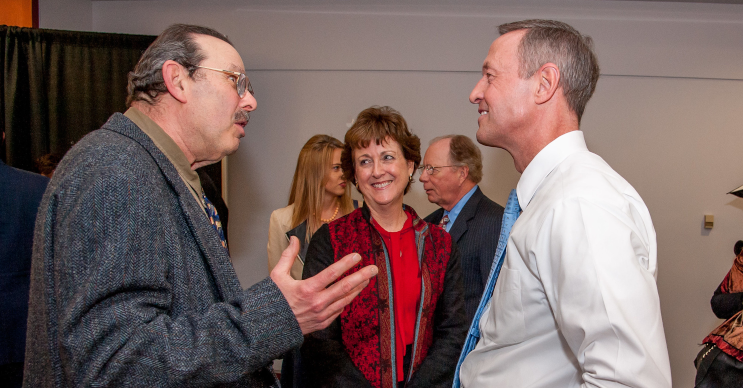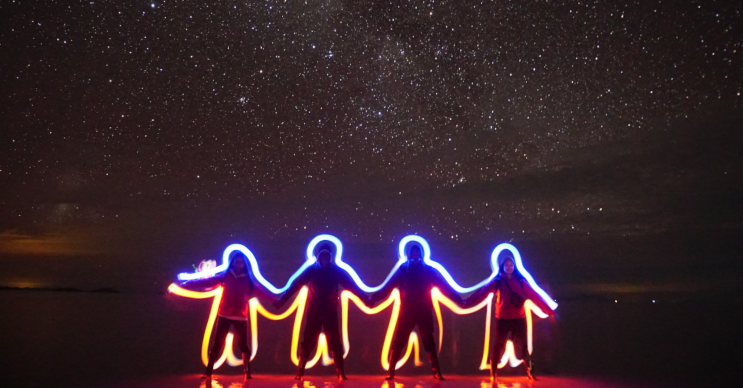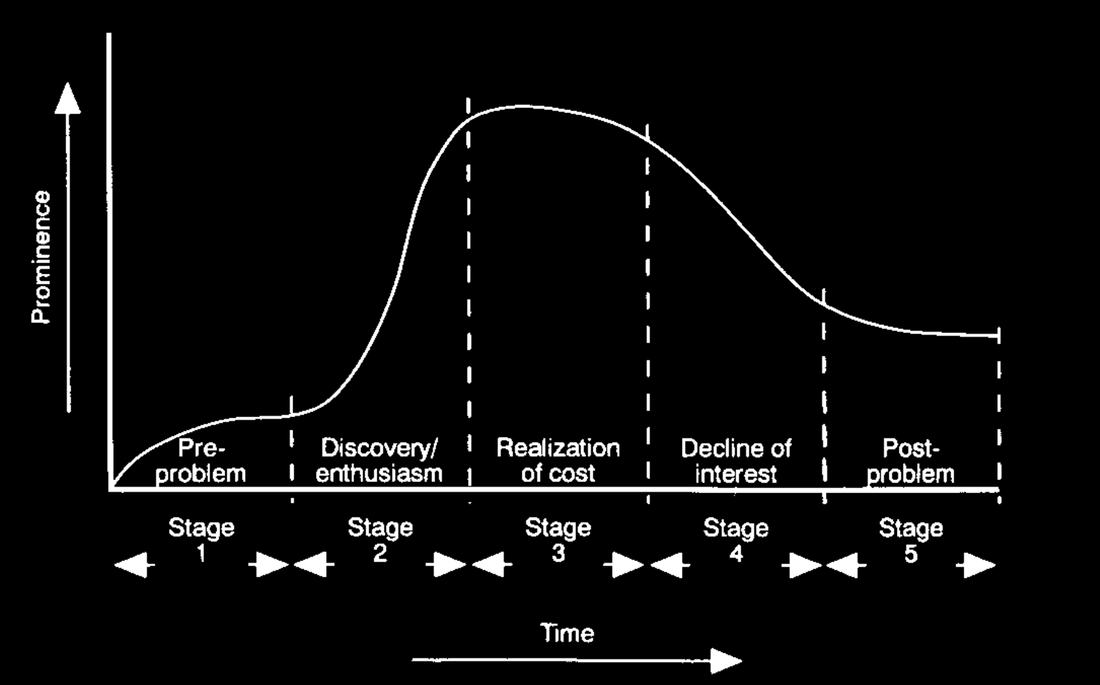Archives
June 2024
Categories
All
|
Back to Blog
Light Pollution and Climate Change2/1/2024 Image credit: International Accountability Project / CC BY-NC 2.0 1387 words / 6-minute read Summary: Light pollution represents wasted electricity, which in turn means millions of tons of greenhouse gases added to the atmosphere every year. Even when we use energy-efficient outdoor lighting, the world's never-ending tendency to consume more resources causes increasing emissions of climate-warming carbon. Reducing our use of outdoor artificial light at night can help solve both the problems of light pollution and global climate change. In January 2024 we wrote about a big idea that follows from U.S. environmental policy history: the idea of a "Clean Night Skies Act". In a similar vein, many people are looking toward policy models to address other big environmental problems like global climate change. That, too, intersects with light pollution, energy production and consumption, and environmental policy. In this month's post we focus on the ways in which light pollution is an influence on climate change — and what we can do about it. Wasted light is wasted energyWe light the world at night in remarkably inefficient ways. Think about the typical street light, for example. From source to destination, where does the light go? More importantly, how much of the light reaches the intended target? Some loss occurs within the light fitting or fixture itself. Much of the light may not reach the target, instead illuminating things and places where it is neither wanted nor needed. Often the light travels upward into the night sky, either directly from the source or after reflecting from a surface. And much of the world's outdoor lighting is operated at times when no people are around to make use of it. The result of all these effects is that very little light actually makes it to the viewer's eye. By one estimate, less than one photon, or particle of light, out of move than 22 million reflected from a surface is actually useful for human vision at night. [1] That means that we generate considerably more light at night than ever reaches viewers' eyes. The resulting sense of waste is staggering. In turn, it means that we use a lot of energy to power all that lighting. DarkSky International estimates that the world spends at least $50 billion each year to produce light at night that escapes directly to space. [2] In the U.S. alone, outdoor lighting consumes some 380 terawatt-hours of electricity per year. That's enough to power 35 million homes for one year. And well under 1% of that energy produces light that achieves its intended effect. All that wasted energy comes at more than an economic cost. The world produces over 60% of its electricity by burning fossil fuels. [3] If even 1% of that production takes the form of wasted light at night, that's still 146 million tons of carbon dioxide emitted into the atmosphere every year. [4] Although renewable energy sources make up an increasing share of total world electricity production, they're not yet enough to offset these emissions. Human-caused carbon emissions continue putting more heat energy into our atmosphere with increasingly dire consequences. There's no escaping the conclusion: light pollution is making the problem of climate change worse. The 'greenwashing' of energy-efficient lighting?When confronted with this news, many people think that it can't be as bad as it sounds. After all, we live in the era of very energy-efficient light sources like light-emitting diodes (LEDs). And at a certain level, that's true: LED and other kinds of 'solid-state lighting' are very efficient. In fact, many LED lighting products routinely achieve efficiencies about ten times higher than earlier technologies like incandescent filament lamps. If LED replaced those old lamps on a one-for-one basis, we would expect global energy use from lighting to start coming down. In 2017 the United Nations Environmental Programme estimated that a transition to energy-efficient lighting would reduce global electricity demand for lighting by 30–40% by 2030. [5] But that doesn't seem to have happened yet. In fact, it may be that there has been no energy benefit from LED lighting at all. Along with the rapid adoption of LED for its perceived energy savings came a vast decrease in the cost of LED lighting equipment. The price of that equipment fell by a factor of 15 during the decade of the 2010s, [6] making LED suddenly very affordable. As the up-front cost of replacing earlier technology with LED declined, the "payback time" through energy savings decreased. Many governments felt they couldn't turn down the opportunity LED presented. This is an example of what economists refer to as "elastic demand": as the price of something drops, demand for it tends to goes up. We experience this in everyday situations. For instance, when the price of gasoline/petrol goes down, do you drive less or more? In this case, plummeting LED prices seems to have led to strong elastic demand for lighting products. In the first half of the 2010s, satellite measurements of light at night revealed steady increases over much of the world. Those increases mirrored changes in global economic output during the same period. The authors of a 2017 study on this concluded that "the results presented here are inconsistent with the hypothesis of large reductions in global energy consumption for outdoor lighting because of the introduction of solid-state lighting." [7] It is possible that there has been no net environmental benefit due to the introduction of highly energy-efficient lighting. If this is true, then then situation becomes circular. The very factor that influenced the rush to adopt this technology was not realized in the end. If anything, the available evidence suggests that LED encouraged the use of more light at night. It seems to have resulted in installing lighting in places it where didn't previously exist and adding more to places where it did. One way to look at the outcome it is that the world traded one environmental problem for another. Air and light pollution over Poznań, Poland, in December 2016. Credit: Flickr/Sakuto, CC BY-NC 2.0. Reducing light pollution means real energy savingsMaybe we have the notion of "efficiency" all wrong. Lighting scientists and engineers, and policy makers following their advice, focused on raw energy consumption. But their obsession with "lumens per watt" seems to have led us down the wrong path. Worse, given certain realities in terms of human behavior, LED may have not achieved its stated goals at all. It made light cheap, and people consumed more of it without attention to its negative consequences. Real energy savings, and real carbon emissions reductions, come from cutting consumption of light at night. The Five Principles for Responsible Outdoor Lighting embody this idea:
Adherence to these principles has the immediate result of eliminating pure waste. More savings come from lowering light levels to safe thresholds and not exceeding them. In addition, the use of adaptive lighting controls tailors availability of light to meet needs, extinguishing it otherwise. The way to turn the corner on the problem of light pollution fueling climate change is to encourage mindful application of outdoor lighting. This model has the effect of reducing both energy consumption and light pollution. In turn, reducing electricity use lowers costs and encourages resilience in the face of climate change. The good news is that there is no down side to this approach. It does not entail giving up anything to achieve the stated benefits. Illumination levels remain adequate, preserving public safety. Governments and end users realize the benefits of energy and cost savings. The nighttime environment suffers less from light pollution. And in world that desperately needs a "win" on environmental issues, reducing the impact of light pollution may be the easiest win of all to secure. References[1] Bará, S. (2022). A note on the overall efficiency of outdoor lighting systems. Zenodo. https://doi.org/10.5281/ZENODO.6588229
[2] DarkSky International. (2022 August 2). "Light is Energy: Estimating the Impact of Light Pollution on Climate Change". https://darksky.org/news/light-is-energy-estimating-the-impact-of-light-pollution-on-climate-change/ [3] International Energy Agency. (n.d.) "World Energy Balances: Overview" https://www.iea.org/reports/world-energy-balances-overview/world [4] International Energy Agency. (March 2023) "CO2 Emissions in 2022" https://www.iea.org/reports/co2-emissions-in-2022 [5] United Nations Environmental Programme. (2017 October 2). Accelerating the global adoption of energy efficient lighting. https://www.unep.org/resources/publication/accelerating-global-adoption-energy-efficient-lighting [6] Freeing Energy. (n.d.) "Energy Fact – Cost of LED lighting dropped 15-times as volumes increased" https://www.freeingenergy.com/facts/led-bulb-light-cost-price-historical-decline-g213/ [7] Kyba, C., et al. (2017). Artificially lit surface of Earth at night increasing in radiance and extent. Science Advances (Vol. 3, Issue 11). https://doi.org/10.1126/sciadv.1701528
0 Comments
Read More
Back to Blog
Image credit: Shane Burkhardt / CC BY-NC 2.0 1774 words / 7-minute read Summary: Recent years have seen the 50th anniversary of landmark U.S. environmental policies that achieved tremendous success in pollution reduction and natural conservation. As the awareness of artificial light at night as a significant source of environmental pollution rises, we examine whether a similar federal regulatory approach could meaningfully reduce light pollution in the United States. Light pollution is a serious environmental problem, but we have effective technical solutions in hand. Where the political will exists to confront the problem, public policy enshrines the decision and brings consequences if the law is not followed. In the United States, policies governing the use of outdoor lighting are usually made at the local level. With tens of thousands of such local governments, achieving change in the U.S. has been slow. But environmental history offers an alternative approach that could produce meaningful results. We call this effort the "Clean Night Skies Act". Is it a realistic option? A moment 50 years in the making2019-2023 saw the 50th anniversary of several landmark U.S. environmental policies. These include the Clean Air Act, Clean Water Act, Endangered Species Act, and the National Environmental Policy Act. The period from the mid-1960's to the early 1970's marked a major shift in the way the U.S. manages pollution control and natural conservation. Before that time, the few environmental policies existed. There was not yet a broad understanding of the potential for human activities to harm the environment. But it was becoming clear that those activities were often harmful to both people and wildlife. The pace of environmental change accelerated after the Second World War. Pollution from heavy industry fouled the air over U.S. cities and poisoned its waterways. In 1962, the American conservationist Rachel Carson published Silent Spring, a book now considered a classic of environmental literature. Focusing on the effects of the indiscriminate use of chemical pesticides, Silent Spring was a clarion call. Many regard its publication as the start of the modern environmental movement. In considering the problems that Carson described, it became evident that many of the underlying problems are cross-boundary. That is, they don't respect jurisdictional boundaries. Air and water pollution drift from the places they are emitted into other regions. Endangered species can roam across large territories. Earlier attempts to control pollution and promote conservation at more local levels thus failed, and environmental quality in many places in the U.S. was poor by the mid-1960s. This was the result of rapid economic expansion, population growth, industrialization and urbanization in the century since the Civil War. Firemen stand on a bridge over the Cuyahoga River to spray water on the tug Arizona, as a fire, started in an oil slick on the river, sweeps the docks at the Great Lakes Towing Company site in Cleveland, Ohio, on 1 November 1952. (Public domain) Public attention to the problem rose during the second half of the 1960s. Two environmental disasters in 1969 were turning points in the story: the Santa Barbara oil spill in January-February and the fire on the Cuyahoga River in June 1969. Life magazine documented the latter with a photo spread in its August 1 issue, and Americans were horrified by what they saw. Faced with rising public alarm, Congress took action. Investigations showed decades of federal mismanagement of America's environment and natural resources. The problem and its proximate causes were clear, and the public demanded significant change. In the span of only four years, Congress created all the major pieces of modern federal environmental policy. Those laws were spectacularly successful. Emissions of air pollutants in the U.S. have dropped almost 80% since 1970. About 99% of all creatures listed under the Endangered Species Act have avoided extinction. If efforts to address these problems were undertaken only at the local level, it's unlikely these incredible results could have been obtained. And some states have enacted their own stronger or more restrictive policies governing environmental issues within their boundaries. From idea to lawThe U.S. federal government makes and implements environmental policy through a distinct process. Congress investigates issues and sets high-level goals and requirements in legislation. These acts establish new agencies to write regulations flowing from the goals of the legislation, or task an existing agency with the job. Agencies then write regulations through the federal rulemaking process, which includes public input. Enforcement actions are brought either within the agencies or through the federal courts. Courts may overturn regulations or acts of Congress in part or in whole. Congress may revisit environmental legislation and amend it if things aren't working well. And even when environmental policies become law, it usually takes the efforts of outside intervenors to ensure that the government enforces the laws as it should. How might this approach work if applied to reduce light pollution? First, Congress would take up the matter by putting its on its legislative agenda. Interested members of Congress may direct their staff to collect information on the topic. It may hold hearings on the subject, and some Members may state their willingness to sponsor legislation. Either chamber, or both, could consider simple resolutions to the effect that it is the sense of the chamber that the issue is important. Up to this point, the political risk associated with participation is low. If Congress moves toward writing new legislation, the stakes suddenly become higher. Depending on the exact content of a bill, legislators may be more or less willing to support the effort. It can take many years or even decades to achieve the consensus in Congress required to move major legislation. Once the consensus emerges, the rest of the process can move with lightning speed. U.S. President Richard M. Nixon signs the National Environmental Policy Act into law at the White House on 1 January 1970. (Photo courtesy of the Nixon Presidential Library) Promise and challengeThe Clean Night Skies Act is patterned on the environmental bills of the 60's and 70's. The text of the bill itself need not be lengthy or complex. It finds that, under some circumstances, artificial light at night (ALAN) is a harmful environmental pollutant and makes light pollution reduction a priority for the country. It then tasks the Environmental Protection Agency with writing regulations aimed at reducing its influence. As with other environmental pollutants, the EPA would determine "safe exposure" thresholds to ALAN. It would direct states and municipalities to come up with their own plans and policies to achieve light emissions standards. And just like in the Clean Air and Water Acts, it would fine jurisdictions that failed to hit the targets. A lot of factors favor taking this kind of approach. There is a scientific consensus on the significance of the problem. We're not waiting for a technical solution to that problem — we know what works. The solution involves merely reducing wasted outdoor light at night, which has no obvious downside. And better outdoor lighting that reduces light pollution has the extra effect of improving nighttime visibility, which in turn enhances public safety. But there is a lot that must happen first before we can get there. Light pollution really isn't on the federal policy agenda right now. Only some states have confronted the issue with legislation, but more seem interested every year. A Clean Night Skies Act starts with building a coalition of supporters in Congress. We must articulate a rationale for policy change (we're working on that). We have to educate Congressional staff about light pollution and ensure continuity across election cycles to keep the issue on their radar. It's true that the Clean Night Skies Act faces significant headwinds right now. The American electorate is bitterly divided over almost every issue. Light pollution is often framed as an "environmental" issue, making it an instant turn-off for some voters. We have to overcome complacency and political malaise that prevents the country from dealing with its problems. The American public perceives that outdoor ALAN is cheap to consume and has no downsides to its use; plus, people are afraid of the dark. Congress is in a state of near-total paralysis, enacting fewer than one percent of introduced bills this term. And there is some concern that light pollution as an environmental concern could be swept aside by attention to climate change. In the meantime...More importantly, light pollution hasn't yet had a "river on fire" moment that tips the balance toward a definitive solution. It is still acceptable in our society, given that its manifestations are often unseen by most people. Of those who know about light pollution, many associate it with astronomy and conclude that it's not a problem for them. As the world continues to brighten, we risk this "window of acceptability" both shifting and widening. In the meantime, there are alternatives. We could invoke existing environmental laws and argue before courts that they do (or at least should) apply to light pollution. But there are difficulties with this. In 2010 a group of light pollution activists sued the EPA, which had resisted calls to regulate light pollution under the terms of the Clean Air Act. The court sided with the government, finding that the Act's definition of "air pollutant" did not include ALAN. The message to the petitioners was, in short: if you want Congress to regulate light pollution, you must ask it to do so in the form of either new legislation or an amendment to the Clean Air Act. Although some other argument might carry the day, it seems that courts are unlikely to rule differently in the future. Another stopgap option is to convince a presidential administration to take action by executive order. As the Biden Administration took office, DarkSky International urged the President to issue an executive order regulating outdoor lighting on federal property. So far the Administration has not responded to the request. Even if it chose issue such an order, its effect would be limited in scope and fall far short of what the Clean Night Skies Act aims to achieve. Still, doing so would send a strong message to Congress that could help the Act's chances of becoming law in time. Lastly, we should continue to watch the ongoing experiment in state legislatures across the country. Several states have enacted pieces of light pollution legislation in the past 25 years. Others are considering doing so in the current or coming legislative terms. There are also opportunities to strengthen building and energy codes in the states, which sometimes govern how outdoor lighting is used. Change in U.S. Gross Domestic Product and emissions of six common air pollutants, 1980–2018. These data show that meaningful pollution reduction can be achieved without necessarily inflicting economic harm. Graph from resources.org; data sourced from the Federal Reserve Economic Data and the Federal Reserve Bank of St. Louis. The road aheadSo where do we go from here? It pays to pursue an approach with many prongs. We shouldn't wait around for Congress to take action. For now, we can continue working from the bottom up from municipal councils to state legislatures. Advocates can raise the issue with members of Congress and their staffers, informing and educating them about both the problem and its solutions. We should state what it is we want from the federal government in the way of policy, and use that agenda to draft prospective legislation.
If all this sounds like a major undertaking, that's because it is. Big problems often become inter-generational efforts as one group works on the project for some years and then hands it off to their successors. The Clean Night Skies Act may take many years to become the law of the land. Its success requires sustained attention, which in turn means keeping eyes on the prize. The future of our nighttime environment may depend critically on its success.
Back to Blog
Image credit: Jonathan Petersson/Grizzlybear.se 1187 words / 5-minute read Summary: The extent and brightness of skyglow depends significantly on what happens near the ground. Rain, snow and ice can all change how artificial light moves through the nighttime environment, and the way we measure and model light pollution must adapt to ever-changing weather conditions. Winter is underway in the northern hemisphere. For many people who live at northerly latitudes, this means cold weather. There are many factors that effect how bright the night sky is, which we wrote about here and here. (Note that we also previously explored whether holiday lighting is a concern this time of year. ) Winter weather patterns can become of those influences. How do these patterns affect the ways artificial light at night (ALAN) moves through outdoor spaces? And how does this in turn change the brightness of the night sky? How light moves through the atmosphereFrom source to target, outdoor light interacts with the components of the atmosphere. That can change the color of the light, its distribution in space, and other qualities. In the cartoon picture below, light rays emitted from a street light can take various paths before reaching a surface or detector. Some of the light escapes to space where satellites may detect it. Sometimes it reflects off the ground before proceeding up into the night sky. And some light rays end up in our eyes (or, in this case, a telescope lens). But most importantly for our purposes here, the Earth's atmosphere can absorb or scatter light. This happens because constituents of the atmosphere like water droplets, dust particles and molecules are small. That is, they are comparable to the size of the wavelength of visible light. As their size approaches that of the wavelength of light, they interact more light in more pronounced ways. Since the interaction depends on the wavelength of light, the results can vary. For example, very small particles may scatter light of one color in a preferred way. In this way, the atmosphere can direct light to places far from where a lamp emitted it. This can extend the "reach" of city lights into remote locations that are very sensitive to light pollution. Air pollution can make this even worse. Light interaction with cloudsClouds are regions of the atmosphere where the "phase" of water has changed from a vapor to a liquid or solid. As individual water molecules clump together, their optical properties change. So we expect that the way light moves near and through clouds is different than when it moves through clear air. Clouds tend to be gray from a color perspective. That is, as light passes through clouds, the water scatters or absorbs light in ways that don't depend on the light's color. Often when we see clouds in the daytime their tops are white but their bottoms are gray. Both white and gray are the same color, differing only in their intensity. A ray of sunlight reflected from the top of a cloud looks white. But rays emerging from the bottom of a cloud, dimmed from absorption by water droplets, looks much less intense. In light-polluted places, cloud bottoms are bright. They 'amplify' skyglow by reflecting more light back to the ground. Changes to lighting on the ground can change the colors of clouds. In naturally dark places, they're black. They absorb airglow and starlight, both of which are natural sources of light at night. In short, clouds make bright places brighter at night, and dark places darker. Light from a commercial greenhouse in the Netherlands reflects from low clouds at night. Photo by JW van Wessel, licensed under CC BY-NC 2.0. This matters as the world's climate continues to change due to human activities. A warmer climate in much of the world means more clouds. More clouds in turn mean brighter nights both in and beyond cities. We don't yet know what this means for the ecology, but it could be a problem for wildlife conservation in otherwise dark places. Light interaction with outdoor surfacesThe weather also changes the optical properties of surfaces. Imagine materials like dirt, concrete and asphalt. After a rain shower, they all look darker to the eye. The materials absorb water, which in turn makes its refractive index more like that of air. It is then less likely to reflect light rather than absorb it. Surfaces covered by ice and snow tend to look white. The multitude of hexagon-shaped ice crystals that make up ice are great at reflecting (and refracting) light. That means ice reflects much of the light incident on surfaces it covers, making it more and more mirror-like. This effect also amplifies skyglow. Even when the sky is clear, snow and ice on the ground in and near cities makes the night sky brighter. The two effects can combine together, too. One study found that, in an environment with a lot of ALAN, cloudy nights with snow on the ground can be as much as 3500 times brighter than a clear night in a remote location. Such bright conditions have profound effects on the nighttime environment. What this does to measurements and modelsThe effect of weather on our efforts to understand light pollution is significant. One way is by changing the amount of light at night measured by satellites and other remote sensing platforms. A rain-dampened surface can look darker than it is when dry, while an icy surface can increase its apparent brightness as seen from orbit. These effects can add in with others, like changes in leaf cover on deciduous trees, to produce changes in ground brightness that vary according to the season. This effect is evident in satellite data. In winter, with ice on the ground and trees bare of leaves, cities look a little brighter. In summer, the reverse is true. But we can account for this with careful study and correction of our measurements. Weather also impacts our ability to make accurate models of light pollution and skyglow. We now have mathematical models that are very good at predicting skyglow under clear conditions. The physics of light transmission are well-understood. Computing power has increased by leaps and bounds in recent years, and models now run quickly on desktop computers. But it starts to get complicated once the properties of the atmosphere change. The momentary state of the atmosphere then becomes important. We can simulate simple situations, like a uniform layer of clouds over a city. But more realistic weather becomes progressively more difficult to model. We are still far from making reliable skyglow models that deal with weather in believable ways. Darkness is important even in places that are cloudy!With all this talk about weather and skyglow, it's easy to think things are hopeless. Of course we can't do anything about the weather. But even in very cloudy places, where seeing the night sky is rare, it's important to prevent light pollution. Such conditions are "darker than dark" and provide refuge for threatened species. In and near cities, the problem is even more acute due to the amplification of skyglow by clouds. These areas need even more consideration to limit the effects on urban wildlife.
No matter what the weather is like, protecting darkness has distinct social and environmental benefits. Solutions are simple and cost effective, but navigating the complexity of options can be challenging. Every day, we help clients understand the sources of light pollution and their best options for reducing it. Contact us today to find out how we can help you achieve your dark-sky goals.
Back to Blog
How to talk to elected officials11/1/2023 Image credit: Office of the Governor / Maryland State Archives 1737 words / 7-minute read Summary: Elected officials are the gatekeepers to public policy matters. Efforts to establish or change outdoor lighting policies depend crucially on knowing how to work with them most effectively. This post discusses winning strategies to advance policy proposals to enactment. Public policy is an important tool in creating lasting social change that may decrease light pollution over time. We have written here before about policy matters here, considering the motivations ("Why pursue an outdoor lighting policy in your town or city?") and important elements ("Good/Better/Best Outdoor Lighting Policies"). But how do technical concepts and policy proposals on the use of outdoor lighting become law? In short, they must withstand scrutiny by, and gain the support of, elected officials. In some democracies the legislative process may seem to outsiders like a daunting prospect. Yet in most cases it starts with simple conversations that develop into relationships. In this post we will look at ways to influence that process by communicating with elected leaders. It starts by understanding how the relevant level of government works. Understanding how policy agendas are set is important. But most significant is learning a new language of politics and procedure. Catering to these issues is the key to becoming an insider. Here we'll look at each of these ideas in turn. A brief civics lessonIn most Western countries, policies that affect the use of outdoor lighting are made at the national level. These policies filter down to the level of individual cities and towns, which must follow them. An example is France, which sets legal standards across its territory that all jurisdictions must observe. Some countries with federal systems devolve the authority to set these policies onto lower levels of government. This is true in the United States and Canada, where lighting policies originate at the state/province of municipal level. In still other countries, like Mexico, the central government sets very high-level standards and leaves lower governments to decide how to implement them. This may be confusing to people who have no prior experience in dealing with government other than voting. It may require a consultation with an attorney to figure out which jurisdiction governs lighting. But it’s important to figure out early in the process in which jurisdiction your lighting problems exist. This ensures that efforts to address those problems target the proper level of government. Doing so also means time is not wasted asking for solutions that a given level of government isn’t empowered to address. One more point of significance here is what kind of law is best to pursue. Statutory laws are familiar to most people. These are proposals written by legislative bodies that endure the political process before becoming laws. Many Western countries also have some form of common law, which is a series of mostly unwritten precepts derived from history and tradition. Certain legal notions like nuisance derive from the common law. And third, most governments have some sort of administrative or regulatory procedures that function like laws. Sometimes the change one wants to bring about don't demand new laws at all. A changing interpretation of an existing law can yield the same result. Driving the policy agendaIt's not enough to know to which level of government one should present a policy idea. Governments everywhere face many concerns vying for their attention. Representative democracies are in part designed to address this situation. Constituents vote not only for candidates but for the ideals and priorities they espouse. Competition among policy proposals places them on a policy agenda for legislative bodies to consider. In a recent post we described the "issue attention cycle". This is a model for the process by which policy ideas are generated, considered, implemented and revised. In brief, the cycle works like this. In the first phase, a social problem of some kind emerges as the result of different influences. Public awareness of the problem grows during the second phase. Some people who become aware of the problem realize the cost of inattention to the problem and begin to demand solutions in the third phase. The cycle reaches its peak at the start of the fourth phase in which a policy solution is devised and implemented. As the problem targeted by the policy change diminishes in significance, public attention begins to ebb. In the fifth and final phase, the policy implementation is mature. But new problems may pop up despite the policy change or even because of it. These new problems may then start attention cycles of their own. The extent to which lawmakers are thinking about any given problem depends very much on the phase of the cycle. The days of 'early adopters' may see no interest at all from elected officials. Often it is only when a problem becomes acute (and even severe) do officerholders begin to pay attention. But elected representatives are always mindful of their terms of office. They know that, on a reliable schedule, voters will hold them to account for their time in office. This often makes officials very sensitive to public perceptions of issues. If they hear from enough of their constituents to the effect that an issue is important to them, they are more likely to take steps to address it. The timing of issue advocacy is thus crucial to the success of efforts to bring about change. Successful advocates for change study trends in political discourse very carefully to choose the best time to make policy proposals. The foundational work needed to bring society up the "hill of awareness" may be long, lasting sometimes even decades. Deploying a proposal too soon usually leads to elected officials ignoring it. Waiting too long invites complacency and a sense that adverse outcomes are inevitable. Careful stewarding of proposals through the attention cycle seems to yield the best results. Making friends in high placesPolicy ideas become law through a complex process of influence that caters to the needs of the people whose input is necessary at different steps along the way. Sometimes that’s a policymaker; other times it’s staff, and at certain points it’s definitely the public. All these groups must be carefully managed to anticipate obstacles and figure out ways over or around them. This goes beyond being polite to people. It involved getting to know them at some level and thinking of them as colleagues rather than mere gatekeepers. And despite these relationships, one still might not get the desired outcome in the end. Legislative staff often hold outsized power in setting the detailed policy agenda. They also occupy key positions of influence over the legislative bodies they serve. Staff can bring attention to your proposal to get it on the agenda of the legislature and keep the process moving at the proper pace. They act as the first screen or filer through which policy ideas pass during the enactment process. Furthermore, given the electoral cycle, elected representatives have short time horizons. As professional employees, staffers often last much longer in their positions. They are the repository of information transmitted from one generation of lawmakers to the next. Sharpening the argumentNext comes the policy idea itself. This is the core of every change movement. Don't just complain that you don't like the status quo as it affects the issue at hand. Instead, show why the status quo is inadequate and come prepared to discuss specifics. Bring evidence to the discussion where you can get it. And communicate in a convincing way what it is you want the elected officials to do. Successful policy changes begin as well-constructed, logical arguments. They appeal in equal measure to reason (the mind), emotion (the heart), and feasibility (the gut). Ask yourself: what is the solution, and why is it the right one? Consider alternative policies and explain why they won't work as well (or at all). Expect objections to the solution and game out strategies for responding to them. Elected officials, and their staffers, expect advocates to come to them with an "ask". That is, they presuppose that the purpose of a phone call or a meeting to discuss an issue is to convince the legislator to support some specific action. Advocates should lead these discussions with the ask and provide context establishing a need for the action. They should conclude by making clear that the ask is the right and best way to address the problem. They should also suggest the consequences of inattention to the issue or inaction in response to the ask. Of course, this element should not dramatize the problem beyond what the facts prove. But the argument should convey a sense of urgency that the advocate wants the official to sense and confront. "Success" in this context is turning a skeptic into a supporter. With deepening relationships come trust, and with trust often comes endorsement. You are the expert!Enactment of a new or amended outdoor lighting policy isn't the end of a process but the start of a different one. Once governments decide to improve their lighting policies, often they want help with, e.g., evaluating permit applications and deciding how to enforce rules. They can also use information about lighting and light pollution to educate the public in hopes of increasing support for change. And for this leadership they look to policy advocates as the experts.
Relative to those who write or implement laws, individuals and groups that advocate for those laws are uniquely positioned. Their knowledge of problems and solutions runs deep. Officials may enlist their help during implementation to understand the fine points of a law's requirements. This is a separate matter from legal interpretation, which is for courts to decide. Rather, governments may ask advocates to take part in implementation to ensure it proceeds correctly. The relationships forged during enactment of policy often survive the end of the formal process. Better outcomes seem to result when advocates remain engaged. This may all seem discouraging to the uninitiated. But each advocate starts out new to an issue like everyone else. Like the issues themselves, effective advocacy is something to learn. And experience proves the view expressed by the American cultural anthropologist Margaret Mead, who once famously advised: "Never doubt that a small group of thoughtful, committed citizens can change the world. Indeed, it is the only thing that ever has." If you found this post inspiring but don't know how to get started, we can help. Advocacy for policy change, and supporting successful lighting policy proposals, is at the heart of what we do. Contact us today to find out how we can devise, launch and support policy initiatives in your community.
Back to Blog
Grieving the dying dark9/30/2023 Image credit: Elias Rovielo 1349 words / 5-minute read We know a lot about the effects of light pollution on wildlife, the night sky, and in other areas but not as much about what it does to people. One can find some evidence for impacts having to do with physical health, wellbeing, and even social justice. Studies on mental health in particular are few, and most are about whether artificial light at night (ALAN) influences the occurrence of mental illness. Meanwhile, as humans concentrate into cities, they become distanced from nature. Some scholars speculate on whether separation from nature can have an adverse effect. Might something similar exist having to do with loss of nighttime darkness and routine access to the night sky? A loss like no otherSocial science has started to ask whether people experience a sense of grief or loss at environmental destruction. The Australian philosopher Glenn Albrecht invented a word for it in 2005: solastalgia. Describing it as "the homesickness you have when you are still at home", Albrecht composed it from Latin and Greek words meaning 'comfort' and 'pain'/'suffering'/'grief'. It refers to both anxiety about the state of the environment both now and in the future. In June 2023, the journal Science published an issue with a special section about light pollution. Some 50 years after the term first appeared in its pages, light pollution appeared on its cover. Six review papers presented a summary of what we know about this issue from scientific, social and legal perspectives. In recent years, dark-sky activism and what is now called "community engagement" forged new connections among activists, researchers and others. Through this work I met Dr. Aparna Venkatesan, an astronomy professor and Co-Director of the Tracy Seeley Center for Teaching Excellence at the University of San Francisco. Besides her passion for the the study of the early universe, Aparna is a tireless advocate for diversity, equity and includion (DEI) in science and society. We also share a keen interest in the social consequences of space policy, about which we co-wrote a paper published last year in Nature Astronomy. We have had many discussions about these issues particularly since the dawn of the large satellite constellation era in 2019. We talked about all this in the broader context of loss of humanity's connections to the night sky. We also came to realize that the night sky makes up a kind of intangible cultural heritage, one worth protecting. Aparna suggested a word that parallels solastalgia in its derivation and meaning. "Noctalgia" is a neologism that combines roots for "night" and "pain" to suggest the sense of loss associated with the brightening of the night sky due to light pollution. In a broader sense, it encompasses any influence that changes the character of the night, including on the ground. In August we published an 'e-letter' in Science reacting to the articles in the earlier special section and introducing noctalgia to the world. We also posted the e-letter to the arXiv, a repository of scholarly literature on astronomy and other subjects. The media picked up on the idea shortly after and ran with it. The amount of coverage surprised us (see here, here, here and here). Clearly noctalgia struck a chord. Focusing attention on 'sky grief'Naming things can be an opening to talking about them with more honesty and authenticity. But we also hope that giving a voice to what some people now feel will help move them to take action. That action results from awareness that becomes a demand of society to take on and solve a problem. In turn, that relates to something called the 'issue attention cycle'. Anthony Downs was an American economist who specialized in public policy and public administration. In 1972 he wrote an influential paper called "Up and Down with Ecology — the Issue-Attention Cycle". In it, he argued that to solve social and environmental problems they had to capture and maintain public attention. He also described a cycle of steps from identification of the problem to post-solution effects that can start the cycle over again. As people discover light pollution, awareness rises. According to Downs' theory, some of them will decide that a real problem exists. If it maintains prominence for long enough, a critical mass will form and people will begin demanding solutions from decision makers. Yet it's arguable that the global dark-skies movement is still climbing the "hill of awareness" and that we are not at the peak yet. Even among those who become aware of light pollution, there's no guarantee that they will become part of this movement. Some who experience light pollution may write off the loss of the night as a consequence of progress and modernity. For example, people in developing economies may cite a need for outdoor lighting to enable safe transit at night and a nighttime economy. Given the colonial history in many such places, it's difficult to argue that they shouldn't have access to it. That's true even as we recognize the many ways that ALAN harms humans and nature. Some people might be motivated to do something about light pollution once they give voice (and a name) to the loss they have experienced. But that presumes that they have something to lose in the first place. As the world continues to urbanize, fewer people grow up in places where they can see the stars at night. It remains to be seen whether people who never had access to dark night skies grieve something that to them was never 'lost' in the first place. But that loss is especially acute for some people who have long suffered from deprivation. Indigenous, Aboriginal and First Nations people often live in places where the night sky is still accessible. In many instances, it looms large in their culture, folklore and religion. But these people often have little to do with creating the conditions that lead to light pollution. They also often have the least amount of political power in their countries and hence little ability to do anything about it. For many, the sense of loss is all too familiar. From noctalgia to actionThere is an old saying about how the pace of change determines outcomes: Toss a frog into a pot of boiling water and it will leap out to save itself. But toss a frog into a pot of cool water, gradually warming it up, and the frog will swim around until it boils to death.
People often recognize the severity of problems at different points in time. Some are 'early adopters' of such ideas, while others are laggards that don't get on board until late in the game. And as our world changes, what society considers acceptable levels of risk may shift. The loss of the night can prompt real, palpable grief in some people. But can noctalgia really prompt more people to take action on the problem of light pollution? We don't (yet) know whether the same is true of environmental problems more generally, or the role solastalgia plays. Meanwhile, people everywhere are straining under the weight of the many problems humanity faces. 'Crisis fatigue' is real, and it undermines efforts to solve those problems in definitive ways. But solving the problem of light pollution turns out to be remarkably simple and cost-effective. We don't lack a technological solution — one is in hand right now. It enables us to light the world at night well for human needs while minimizing the negative effects all that light has on the environment. By reducing or eliminating wasted light, we could get a handle on the situation in short order. Of more significance is that humanity desperately needs a win in the environmental realm. Were we to solve the problem of light pollution within a generation, the result might inspire confidence in out ability to take on bigger issues like climate change. But first, we have to finish climbing that 'hill of awareness' that moves people to action. If we do, it could be one of the defining environmental moments of the 21st century. |
 RSS Feed
RSS Feed
